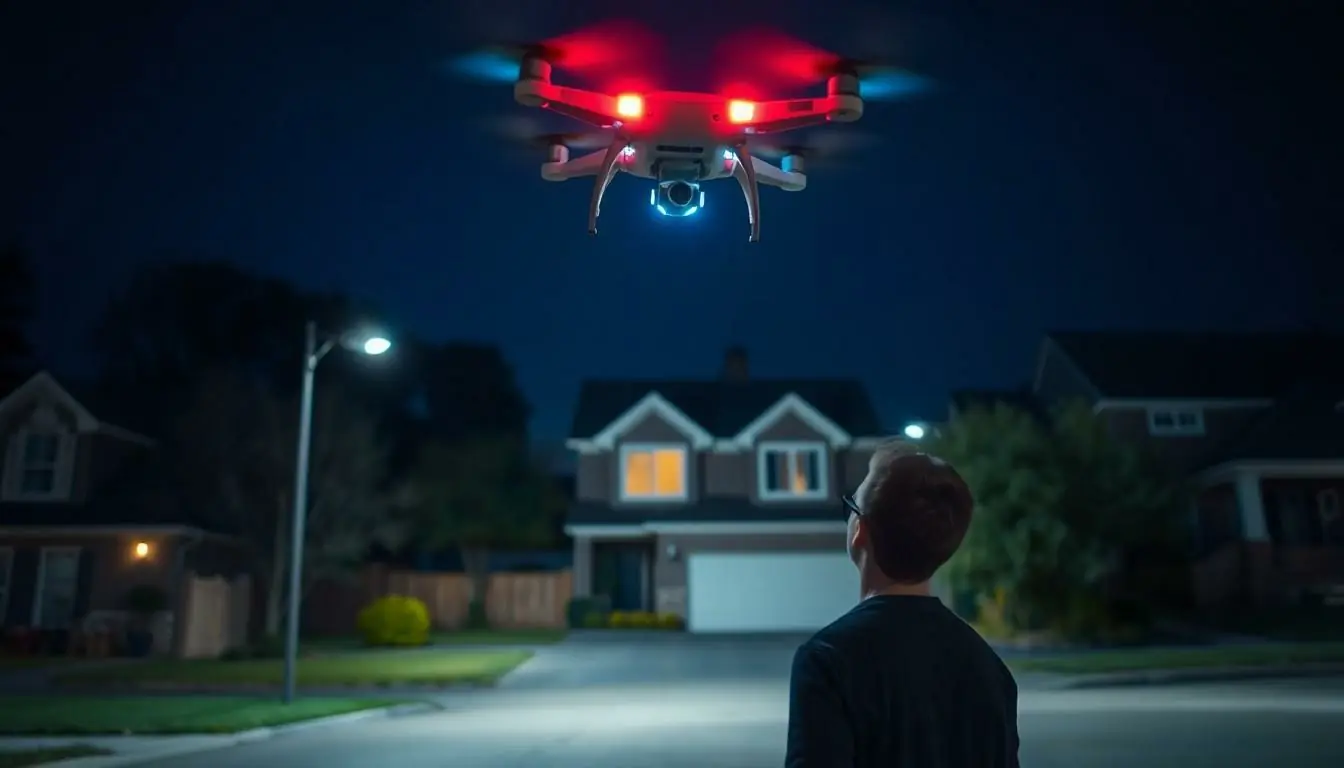Ever looked up at the night sky and wondered if you were starring in a sci-fi movie? Those buzzing drones gliding above your house might just make you feel like you’re living in a high-tech thriller. But what’s the real story behind these flying machines?
Table of Contents
ToggleUnderstanding Drone Activity
Drones increasingly populate the skies, particularly during nighttime. As technology advances, more people engage with drones for various tasks.
The Rise of Drone Usage
Growth in drone usage stems from enhanced accessibility and affordability. Many individuals and businesses now invest in drones due to their versatility. A report by the Federal Aviation Administration indicates the number of registered drones in the U.S. reached over 1.5 million in 2022. More consumers see drones as valuable tools rather than just toys. Popularity surges in sectors like photography, agriculture, and surveillance reflect the rising trends.
Common Purposes for Drones
Drones serve multiple purposes across various fields. In surveillance, companies employ drones for monitoring properties and conducting inspections. The agriculture industry relies on drones for crop monitoring and soil analysis. They enhance emergency services by delivering supplies in hard-to-reach areas. Drones also play a significant role in entertainment, capturing stunning aerial footage for film and social media. Public safety organizations utilize drones to assist during disasters or emergencies, ensuring efficient responses.
Reasons for Drones Flying Over Homes

Drones flying at night sparks curiosity and concern. Various motivations drive this activity.
Law Enforcement Surveillance
Law enforcement agencies use drones for increased monitoring capabilities. They assist in crime scene investigations, search and rescue missions, and public safety efforts. Notably, drones provide real-time data, reducing response times during emergencies. Privacy regulations govern police drone use, ensuring compliance with established laws. The presence of a drone might signal police activity or surveillance operations in the area. Residents noticing drones overhead may wonder about their specific purposes.
Commercial Operations
Many businesses utilize drones for commercial purposes, especially at night. Drones facilitate inspections of infrastructure such as power lines and pipelines. They also contribute to agricultural practices, monitoring crops and livestock after dark. Deliveries of goods using drones are on the rise, making nighttime operations more feasible. Businesses prefer using drones for efficiency, cost-effectiveness, and expanded reach. An observable drone could indicate a nearby commercial operation executing its nightly tasks.
Recreational Use
Recreational drone use has grown, attracting enthusiasts both day and night. Hobbyists often fly drones for photography, videography, and racing events. Nighttime flights may include light shows, showcasing the drone’s LED capabilities. Communities might witness gatherings of drone users, sharing experiences and skills. Regulations often dictate when and where drones can operate, impacting recreational activities. Residents seeing drones at night may encounter this fun aspect of incorporating technology into leisure.
Safety and Privacy Concerns
Drones flying over homes raise important safety and privacy issues. Residents often express concern about potential risks associated with these unmanned aerial vehicles.
Potential Risks of Drones
Drone presence poses various risks. Collisions with buildings or power lines can lead to dangerous situations for both the drone and nearby individuals. Noise pollution from drones can disrupt the peace, especially during nighttime operations when residents expect tranquility. Additionally, surveillance capabilities may result in invasive monitoring of private property. Instances of unauthorized data collection can lead to identity theft or breaches of personal privacy. Understanding these risks is vital for residents as drone usage expands.
Legal Regulations on Drone Flights
Regulations govern drone flights to protect public safety and privacy. The Federal Aviation Administration (FAA) enforces rules that limit drone operations, particularly in residential areas. Drones must comply with restrictions regarding flight altitude and no-fly zones. Local laws often dictate additional limitations based on specific community concerns. Privacy laws also address the use of drones for surveillance, requiring operators to respect personal boundaries. Ensuring familiarity with these regulations can help residents address their concerns regarding drone activity over their homes.
How to Respond to Drone Activity
Residents noticing drones flying at night should stay informed and take appropriate actions. Understanding the situation promotes awareness and ensures safety.
Reporting Drone Sightings
Report any drone sightings to local authorities promptly. Document details such as the drone’s appearance, the time of the sighting, and the location. This information aids in potential investigations and provides officials with necessary context. Many communities encourage residents to use online platforms or hotlines specifically designed for reporting. Engaging in local social media groups can also help gauge others’ experiences and concerns regarding drone activity.
Engaging with Authorities
Residents should approach authorities if drone activity raises genuine concerns. Contact local law enforcement or community boards with any questions regarding privacy or safety issues. When discussing concerns, be specific about incidents and how they affect daily life. Authorities can provide guidance about regulations and investigate any suspicious activities. Engaging respectfully with officials can foster a collaborative approach to addressing community concerns and enhancing safety.
Drones flying over homes at night can evoke a mix of fascination and concern. As their use continues to expand across various sectors, residents are encouraged to stay informed about the reasons behind this activity. Understanding the balance between technological advancement and privacy is essential in navigating these changes.
By fostering communication with local authorities and being proactive in addressing any concerns, individuals can ensure a safe and respectful coexistence with this innovative technology. Awareness and engagement will empower communities to adapt to the growing presence of drones while protecting their rights and privacy.